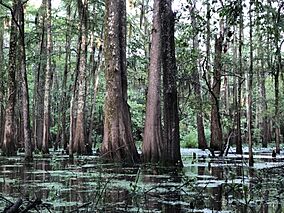Black Bayou Lake National Wildlife Refuge facts for kids
Quick facts for kids Black Bayou Lake National Wildlife Refuge |
|
|---|---|
|
IUCN Category IV (Habitat/Species Management Area)
|
|

Black Bayou Lake National Wildlife Refuge
in Monroe, Louisiana, September 15, 2020. |
|
| Location | Ouachita Parish, Louisiana |
| Nearest city | Monroe, Louisiana |
| Area | 4,200 acres (17 km2) |
| Established | 1997 |
| Governing body | U.S. Fish and Wildlife Service |
| Website | Black Bayou Lake National Wildlife Refuge |
Black Bayou Lake National Wildlife Refuge is a special place in Louisiana. It is a protected area that provides a safe home for many wild animals and plants. This refuge is one of five managed in the North Louisiana Refuge Complex. It is also part of the larger National Wildlife Refuge System, which has over 500 refuges across the country.
The refuge was created in 1997. It started with a unique partnership with the city of Monroe, Louisiana. The United States Fish and Wildlife Service helps manage the lake. They have a long-term agreement to care for this important natural area.
Contents
Wildlife and Nature
Black Bayou Lake is filled with tall cypress and tupelo trees. These trees grow right out of the water. Around the lake, you'll find different types of forests. There are wet swamps, then areas with hardwood trees, and finally higher ground with mixed pine and hardwood trees.
Animals of the Refuge
Many cool animals live at Black Bayou Lake. You might spot alligators swimming in the water. Wood ducks are common, along with tiny bird-voiced treefrogs. Look out for banded water snakes and red-eared slider turtles.
Birds like green herons hunt for fish. On land, you might see coyotes, skunks, and white-tailed deer. The refuge is a great place for fishing. It also provides important resting spots for birds that travel long distances. These include migratory waterfowl and neotropical migratory songbirds.
Protecting Special Species
Scientists from the University of Louisiana at Monroe work with the refuge. They study the fish, reptiles, and amphibians here. One important animal they watch is the alligator snapping turtle. This turtle is rare in many parts of the southern U.S. Its nests are surveyed each year to help protect them. Reducing the number of raccoons helps keep the turtle nests safe from being eaten.
The refuge also has a program to build nest boxes. These boxes help birds like prothonotary warblers and wood ducks find safe places to lay their eggs. Each year, some wood ducks are banded. This helps scientists track their movements.
Forests and Habitats
About 800 acres (3.2 km2) of old farm fields have been replanted with native trees. These trees are important for the health of the forest and the animals that live there. There is also a small area of higher ground. It is home to a group of red-cockaded woodpeckers. This is an endangered species. Some trees have been removed to create the perfect home for these special woodpeckers.
The refuge also has an arboretum and a prairie area. An arboretum is like a tree museum, with over 100 types of native Louisiana woody plants. The prairie area has native grasses and wildflowers. These areas need regular care, like mowing or burning, to stay healthy. Young trees in the arboretum are sometimes protected from deer and rabbits with wire cages.
Controlling Invasive Plants
One big job at the refuge is controlling plants that don't belong there. These are called invasive species. For example, herbicide is used to stop water hyacinths from covering the lake. These plants can harm native wildlife.
Another problem plant is the Chinese tallow tree. People are taught not to plant these trees in their yards. Birds spread their seeds, and the trees can take over natural areas. Workers also remove these trees by hand from the refuge.
Visitor Center and Activities
The main visitor center is a restored old planter's house. It is part of the Black Bayou Lake Environmental Education Center. This center covers 40 acres (160,000 m2).
Next to the visitor center, you can explore the arboretum. It has over 100 different kinds of native Louisiana trees and shrubs. There's also a prairie demonstration area with native grasses and wildflowers.
The center has interactive exhibits inside. You can also walk a mile-long nature trail. Part of it is a boardwalk over the water. There's a 400-foot (120 m) wildlife pier where you can get a closer look at the lake. Other facilities include a boat launch, an amphitheater, and a pavilion. There's also an observation deck with a spotting scope. Informational signs are placed around the refuge.
Volunteers from a group called Friends of Black Bayou, Inc. help a lot. They give thousands of hours of their time to support the refuge.
See also
Images for kids



